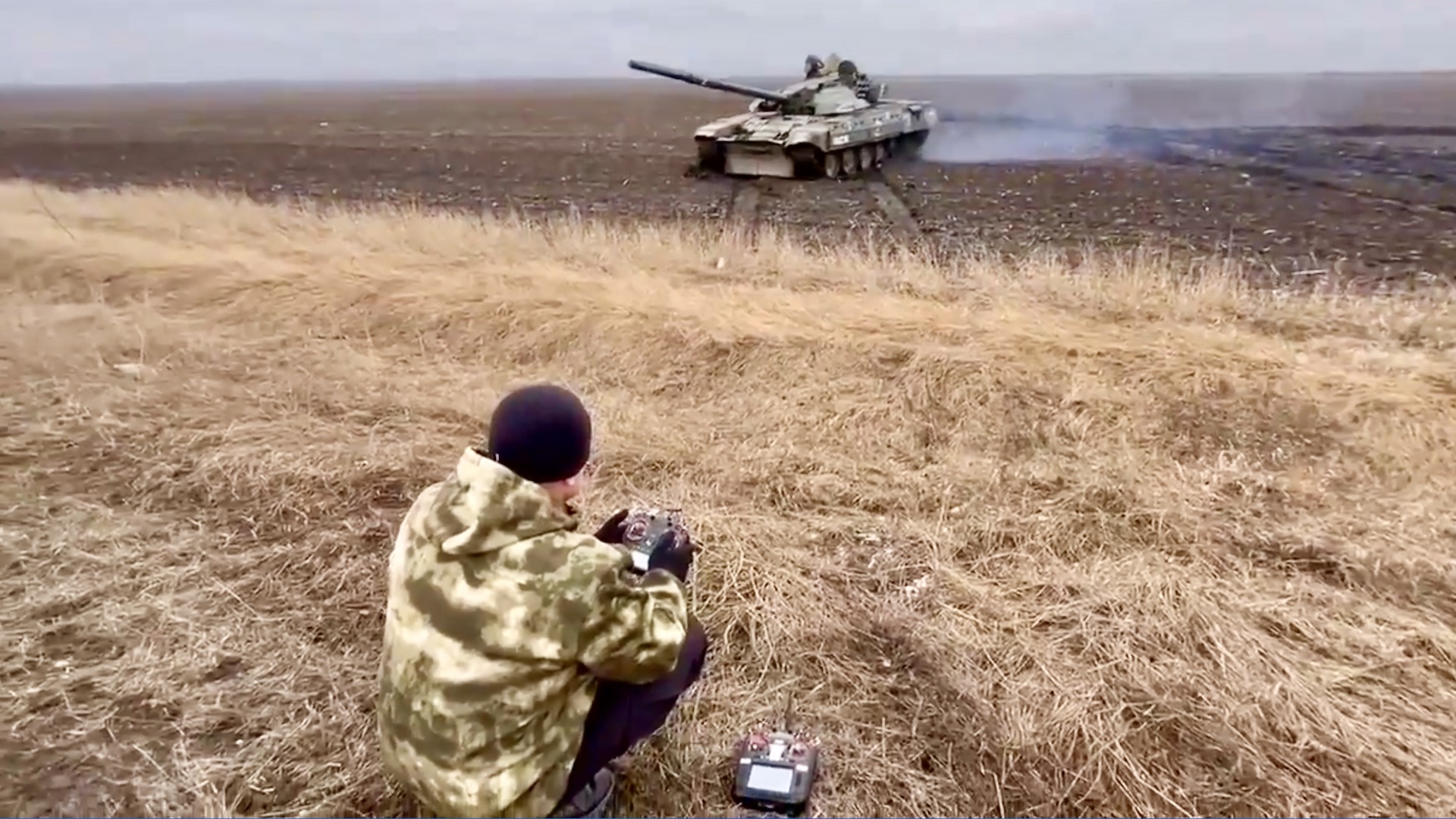In an interesting twist on its use of captured Ukrainian armor, video shows Russian forces experimenting with what’s been attributed as a salvaged T-72AMT main battle tank modified with remote controls. How Russia might look to employ the concept remains unclear, but there is a historical precedent for using remote controlled tanks in mine-clearing operations, or it could even be used as a crude ‘first-person view’ (FPV) tank.
Footage of the modified T-72AMT has recently been circulating on social media. When and where the video was filmed precisely cannot be independently identified by The War Zone.
According to the open-source tracking group Oryx, six Ukrainian T-72AMTs have visually been confirmed as captured by Russian forces, but the true total could be higher. The T-72AMT constitutes an upgraded variant of the T-72A. The first example was handed over to the Ukrainian armed forces in 2017.
The video begins by showing a forward-facing view from inside the tank’s crew compartment. The camera then zooms out, revealing that said view is in fact being transmitted to a headset display. Alongside the headset, we see a Russian soldier holding a remote controller while standing on the edge of a field. It looks as if the turret either has first-person view (FPV) controls, or that the tank as a whole has an FPV control option.


From there, one of the Russian soldiers operates the tank using the handheld remote control system while sitting on the side of the field, which can be seen in the feature image of the article.
A separate frame subsequently shows a soldier maneuvering the tank’s top turret using said remote control system.

Additionally, the video also depicts two individuals operating the tank using headsets and remote controls from a distance; one presumably driving the tank and the other likely controlling its main turret. It is unclear from the footage if any weapons on the tank can be fired remotely.


Of course, Russia is no stranger to re-deploying captured Ukrainian armor for its own purposes on the battlefield. Why it has chosen to add remote control capability to the tank depicted isn’t clear exactly, but as mentioned at the top of this article, there is a historical precedent adding remote controls to tanks for conducting mine-clear operations.
During the war in Ukraine, both Russian and Ukrainian forces have looked to various sorts of crewed equipment to help clear the dense mine fields built up across the country. Most recently, Russia has deployed various ‘turtle tanks‘ in order to clear pathways for other armored vehicles on the battlefield. The first turtle tank example we saw back in April featured a mine plow for this reason, while a more recent variant boasted a KMT-series mine roller.
However, turtle tanks, even those with increased levels of armored protection making them harder to disable or destroy, have proved vulnerable to highly-maneuverable FPV drones. These munitions, which The War Zone has written about extensively, can be used in both attack and reconnaissance roles and, like the remote controlled tank seen in the video above, are operated via a user wearing a headset.
Due to the increasing frequency with which Ukrainian FPV drones have been targeting, and successfully destroying, Russian turtle tanks, there is clearly a need to perform mine-clearing operations with minimal human involvement. We have seen, for example, FPV drones maneuver their way into the driver’s hatches of turtle tanks. Removing the crew entirely from those vehicles would represent a logical next step beyond adding additional armor to them in helping to save lives.
Fitting tanks with remote controls, specifically for mine clearing, is something the U.S. military has done in the past. U.S. Army M60A3 Panther and M1 Panther II Mine Detection & Clearing Vehicles (MDCV), which saw action in Bosnia, Kosovo, and Iraq, could be operated either by an on-board crew or remotely via remote controls, for example, in order to preserve the lives of personnel in highly dangerous locations.

Another possibility is that it could be deployed as an FPV tank of sorts, where it might be used for basic but extremely dangerous tasks. This could include charging front lines. It could also be equipped with large quantities of explosives that could detonate on command. Line-of-sight connectivity between the remote operator and tank would be an issue unless the controllers are in close proximity to it, but a drone that follows the uncrewed tank and acts as a airborne relay could solve that problem.
Finding new and improved ways to reduce risk to armored vehicles and their crews is clearly important to Russia, given the massive loss of armor and personnel it has suffered since the start of the conflict. Although the country has been able to replenish some of its armor inventory, often relying on using ancient tanks and armored vehicles to fill in supply gaps, any opportunity to re-mobilize captured vehicles has been jumped on by the country.
And if this sort of conversion proves successful, it’s possible that it could be adapted to older tank types and armored vehicles in the future.
If nothing else, the addition of remote control capabilities to tanks likely points to the extent to which Russian forces have had to adapt to the changing nature of warfare in Ukraine, especially with regard to drones and mines.
Contact the author: oliver@thewarzone.com
